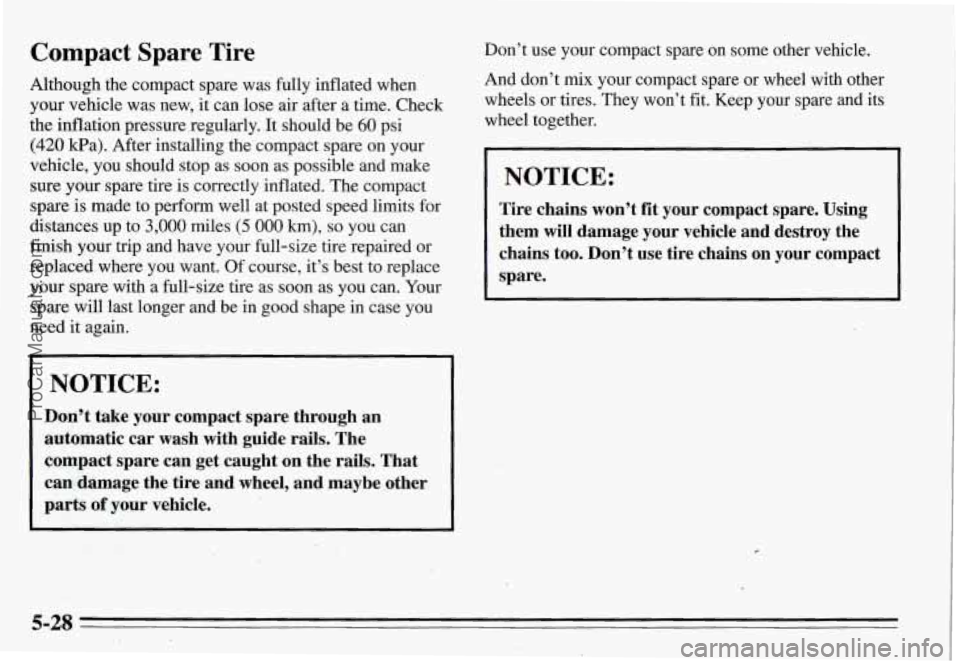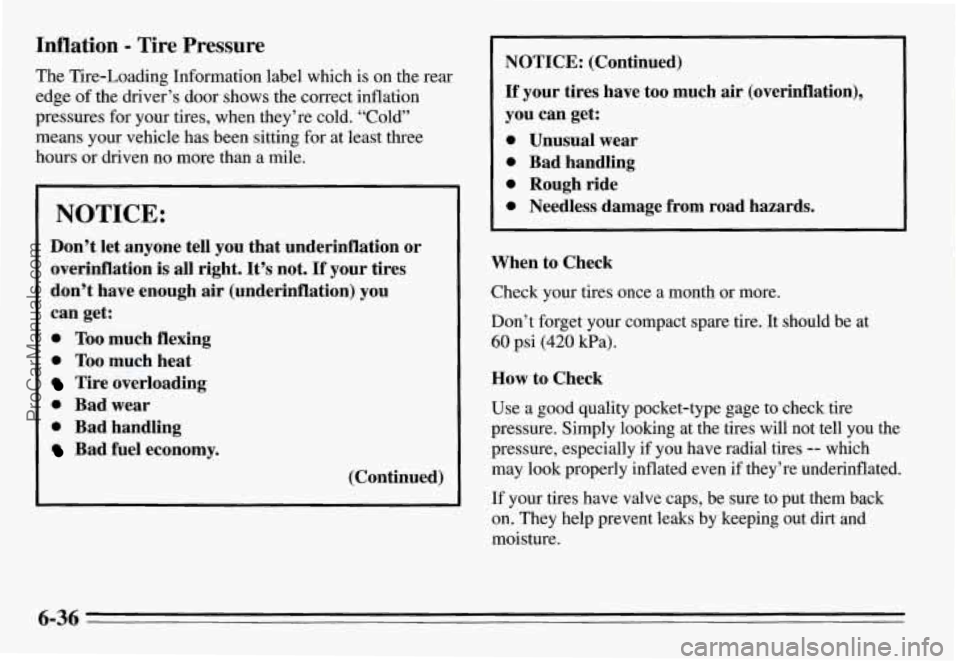Page 203 of 354
The following steps will tell you how to use the jack and
change a tire.
The equipment you’ll need is in the trunk.
1. Turn the center retainer nut on the compact spare tire
housing counterclockwise to remove it, then lift the
tire cover. You will find the jacking instructions label
on the underside of the tire cover,
2. Remove the wing bolt securing the compact spare
tire and spacer by turning it counterclockwise. Then
lift
off the spacer and remove the spare tire.
3. The jack and the wheel wrench are stored in a foam
tray by the compact spare tire.
a few inches.
4. Turn the jack handle clockwise to raise the jack head
5. Using the wheel wrench, remove the plastic cap nuts
(if your vehicle has them) and loosen all the wheel
nuts. Don’t remove them yet.
On some models, a cover plate must be removed to
find the wheel nuts. Carefully use the wedge end
of
the wheel wrench to pry it off.
5-22
ProCarManuals.com
Page 204 of 354
18” (46cm) 18 (46cm)
6. Near each wheel, there is a notch in the vehicle’s
frame. Position the jack under the vehicle. Raise the
jack head until it fits firmly into the notch in the
vehicle’s frame nearest the flat tire. ht the compact
spare tire near you.
NOTICE:
Raising your vehicle with the jack improperly
positioned will damage the vehicle or may allow
the vehicle to fall off the jack. Be sure to
fit the
jack lift head into the proper location before raising your vehicle.
5-23
ProCarManuals.com
Page 205 of 354
I I
NOTICE: I
Do not jack or lift vehicle using oil pan. Pans
could crack and begin to leak fluid.
I
7. Raise the vehicle by rotating the wheel wrench
clockwise. Raise the vehicle far enough
off the ground
so there is enough room for the spare tire to fit.
wheel cover from the wheel, if your flat tire has one.
Then take
off the flat tire.
8. Remove all of the wheel nuts, and carefully pry the
5-24
ProCarManuals.com
Page 208 of 354
Don’t try to put a wheel cover on your compact spare
tire. It won’t fit. Store the wheel cover and plastic cap
nuts in the trunk
until you have the flat tire repaired or
replaced.
NOTICE:
Wheel covers won’t fit on your compact spare.
If you try to put a wheel cover on your compact
spare, you
could damage the cover or the spare.
13. Store the flat tire in the compact spare tire
compartment, and secure with the wing bolt and
extension. Store the jack and wheel wrench back in
the foam tray provided.
I
5-27
ProCarManuals.com
Page 209 of 354

Compact Spare Tire
Although the compact spare was fully inflated when
your vehicle was new, it can lose air after a time. Check
the inflation pressure regularly. It should be
60 psi
(420 Wa). After installing the compact spare on your
vehicle, you should stop as soon as possible and make
sure your spare tire is correctly inflated. The compact
spare is made to perform well at posted speed limits for
distances up to
3,000 miles (5 000 km), so you can
finish your trip and have your full-size tire repaired or
replaced where you want. Of course, it’s best to replace
your spare with a full-size tire as soon as you can. Your
spare will last longer and be in good shape in case you
need it again.
I NOTICE:
Don’t take your compact spare through an
automatic car wash with guide rails. The
compact spare can get caught on the rails. That
can damage the tire and wheel, and maybe other
parts of your vehicle.
Don’t use your compact spare on some other vehicle.
And don’t mix your compact spare or wheel with other
wheels or tires. They won’t fit. Keep your spare and its
wheel together.
NOTICE:
Tire chains won’t fit your compact spare. Using
them
will damage your vehicle and destroy the
chains too. Don’t use tire chains on your compact
spare.
5-28
ProCarManuals.com
Page 246 of 354
Tires
We don’t make tires. Your new vehicle comes with high
quality tires made by a leading tire manufacturer.
These
tires are warranted by the tire manufacturers and their
warranties are delivered with every new Pontiac.
If your
spare tire is a different brand than your road tires, you
will have a tire warranty folder from each of these
manufacturers.
6-35
ProCarManuals.com
Page 247 of 354

Inflation - Tire Pressure
The Tire-Loading Information label which is on the rear
edge of the driver’s door shows the correct inflation
pressures for your tires, when they’re cold. “Cold”
means your vehicle has been sitting for at least three
hours or driven no more than a mile.
I NOTICE:
Don’t let anyone tell you that underinflation or
overinflation
is all right. It’s not. If your tires
don’t have enough
air (underinflation) you
can get:
0 Too much flexing
0 Too much heat
Tire overloading
0 Bad wear
0 Bad handling
Bad fuel economy.
(Continued)
1 NOTICE: (Continued)
If your tires have too much air (overinflation),
you can get:
0 Unusual wear
0 Bad handling
0 Rough ride
0 Needless damage from road hazards.
When to Check
Check your tires once a month or more.
Don’t forget your compact spare tire. It should be at
60 psi (420 Wa).
How to Check
Use a good quality pocket-type gage to check tire
pressure. Simply looking at the tires will not tell you the
pressure, especially if you have radial tires
-- which
may look properly inflated even if they’re underinflated.
If your tires have valve caps, be sure to put them back
on. They help prevent leaks by keeping out dirt and
moisture.
6-36
ProCarManuals.com
Page 248 of 354
Tire Inspection and Rotation
Tires should be inspected every 6,000 to 8,000 miles
(1 0 000 to 13 000 km) for any signs of unusual wear. If
unusual wear is present, rotate your tires as soon as
possible
and check wheel alignment. Also check for
damaged tires or wheels. See “When it’s Time for New
Tires”
and “Wheel Replacement” later in this section for
more information.
The purpose of regular rotation is to achieve more uniform
wear for all tires on the vehicle. The first rotation is the
most important.
See “Scheduled Maintenance Services” in
the Index for scheduled rotation intervals.
When rotating your tires, always use the correct rotation
pattern shown here.
Don’t include the compact spare tire in your tire
rotation.
After the tires have been rotated, adjust the front and
rear inflation pressures as shown on the Tire-Loading
Information label. Make certain that all wheel nuts are
properly tightened. See “Wheel Nut Torque” in the
Index.
6-37
ProCarManuals.com